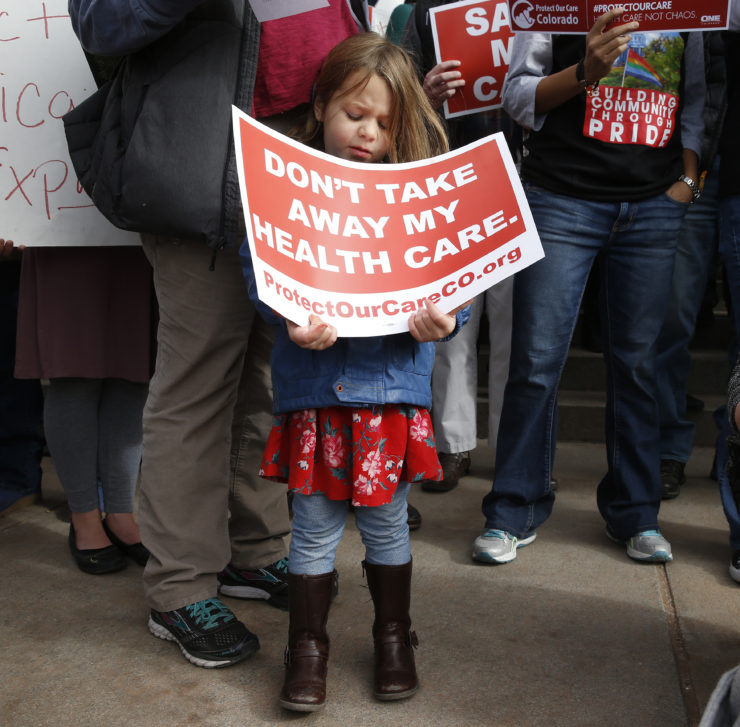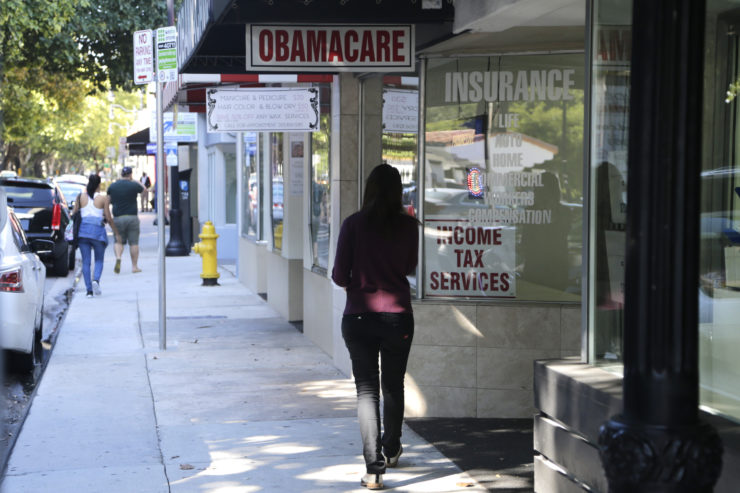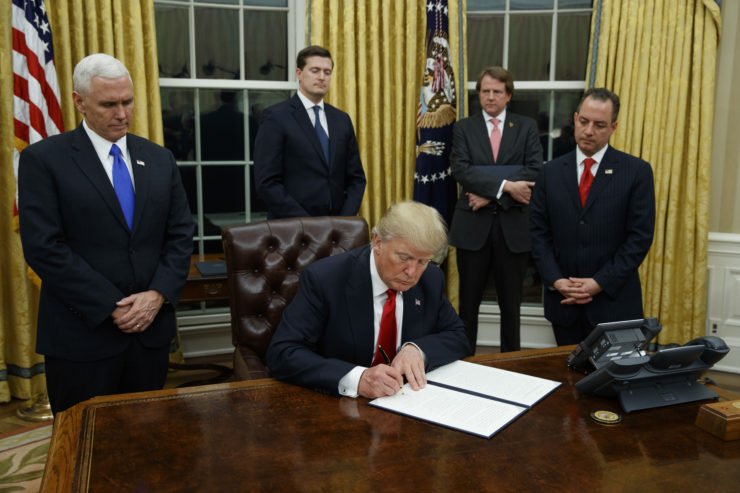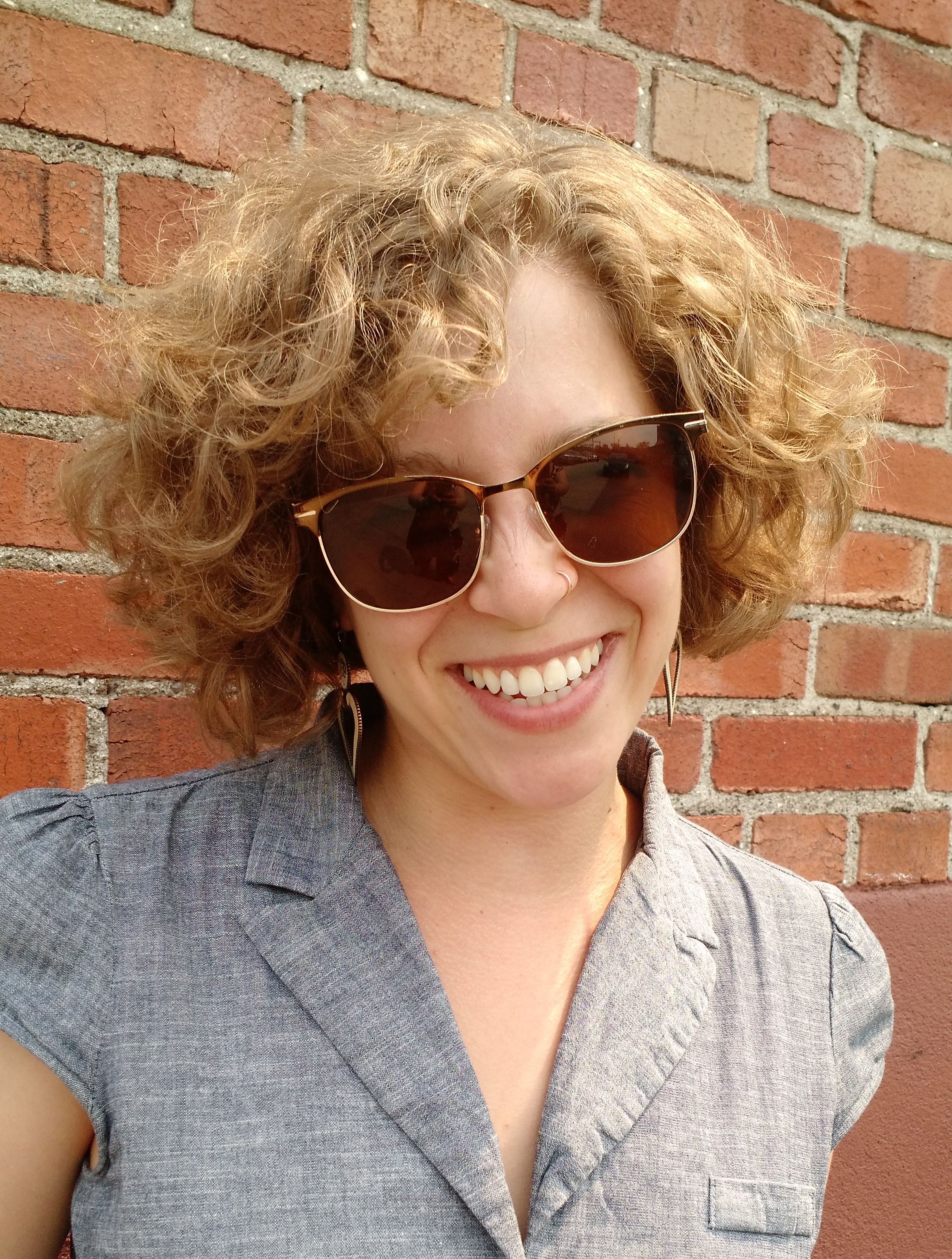
A girl stands holding a sign alongside supporters of the Affordable Care Act in Colorado.
“Life in Obamacare’s Dead Zone,” Inara Verzemnieks’ story about the health insurance coverage gap, came out in the New York Times Magazine a month after the presidential election, as the media buzzed about inaccurate predictions, liberal bubbles and the mainstream media’s failure to notice what was happening in the middle of the country.
Verzemnieks had noticed. She spent months in waiting rooms and living rooms across Kansas, Missouri and Virginia to show us lives familiar enough to resonate — and far enough away to remind us that this is a world we don’t see very closely in news stories.
The fate of the Affordable Care Act quickly became a question mark after Donald Trump’s surprise election in November, and one of his first acts was to issue an executive order seeking its repeal. But politics play a fairly small role in Verzemnieks’ story. More prominent are the snapshots of patients’ everyday lives, which show in precise and often poignant detail just how much more there is to them than that “patient” label.
Verzemnieks’ reportage spans states and a wide range of players in the healthcare labyrinth; translated to literary longform, it shrinks the distance of politics.
Even the existence of facts has been dragged up for debate in the current bitterly partisan climate. Common ground is elusive. Truth gets dismissed as immaterial. Verzemnieks’ story is a reminder of the substance obscured in the promises, threats and criticisms that swirl around the healthcare battle.
Accurate reporting is critical, but it’s not enough. Storytelling may be one of few tools remaining with the power to narrow gaps in understanding by calling on our empathy—and by creating it.
I spoke with Verzemnieks, a 2007 Pulitzer finalist for feature writing, a nonfiction writing professor at the University of Iowa, by Skype in early January; a condensed and edited transcript of our conversation is below.

A woman walks past a sign advertising "Obamacare" in Miami.
Your piece focuses on the people stuck in the health insurance gap. I’m wondering: Is it a story that people want to hear? Did you think about how to make this topic more palatable?
I can answer this in a way that’s almost reverse-engineered. My hope in terms of my ideal journalistic world is that we constantly have a layered approach of coverage to particular issues. Those who can really nail down the solutions-driven piece, they’re going for it, and at the same time that can be supplemented with what I think of as narrative-driven pieces. I think both serve very different functions. There’s something that happens when people have the opportunity to be brought eye-to-eye through the printed word; they’re seeing the richness and fullness and complexity of that life, that body. I recognize that sometimes taking that narrative approach can be at the expense of offering a solution. That said, I still believe that something happens, that narrative comes to live inside people, and what I hope is the next time they have a conversation with someone and this comes up, or they have an opportunity to vote on something, that suddenly the rhetoric becomes replaced with a real story, a rich, full story.
Is there a danger in having these characters—these real people—become representative of this huge problem? The visual descriptions in your piece are so rich and present that I wonder if there’s a sort of paradoxical distance created through literary language.
At the heart of your question is a concern for every writer, and that is: Who wants to be a metaphor? To turn a person into a metaphor can be very dangerous, so there does need to be great care taken in terms of asking someone to hold their entire life, their experience, to hold the weight for a massive issue—no one person can stand in in that particular way. I’m very conscious of not pathologizing someone’s life. I try to think less in terms of problems or how someone is suffering. I’m interested in starting from a place of resilience, in terms of thinking about the workarounds, the end runs, what people are doing for themselves, how they are responding to the situation and what they’re doing that makes them more than just passive projections.
I think back to how it’s so important to me to develop the richness of life. I think that is my way of countering turning someone into a cardboard cutout. There were so many people I spoke to, and many more than found their way into the piece, and then the question becomes: Who do you choose? I’m thinking about those whose stories, even in a short space, can show some sort of arc. What might be a complication that they face in the time that I am with them? How do they respond to that? But I’m also interested in trying as much as possible to have a range of experiences, so that sometimes it is more overt, sometimes it is more soft or subtle.
In many cases, healthcare is part and parcel of larger questions: How do I get to where I need to go in order to be the person that I know I can be and want to be? So you have the grandmother who owns her own business, or we have the young mother who is trying to get to school. I’m also looking for paradox and unintended consequences—that’s another thing that can take those you are profiling out of the role of bit character. How someone responds to that in every case can be unique and different.
I found it very interesting that your piece happened to be about these women’s access to healthcare, but it wasn’t specifically about “women’s care” or reproductive care. It was like stealth feminism, where women were just allowed to be people. Was it a conscious decision to have mostly women in your piece?
It wasn’t, at first. And then as I began to see it on the page, and then looking at the numbers, and at a lot of the people I was running into, I realized that it did represent something sort of interesting. Women are represented quite significantly within the gap, so there’s an interesting layer of what it means to be a caretaker at the same time one is also trying to take care of oneself.
I still believe that something happens, that narrative comes to live inside people, and what I hope is the next time they have a conversation with someone and this comes up, or they have an opportunity to vote on something, that suddenly the rhetoric becomes replaced with a real story, a rich, full story.
You mentioned that your husband was diagnosed with cancer almost in the middle of your reporting this. How did that affect your reporting and writing here?
I talk with my own students about the need to take a moment and take stock of the position that you’re writing from. You need to do that periodically through the entire time that you’re trying to work on something, and sometimes we’re better at it and we’re more conscious than others. For me, there was a continual stock-taking: Where am I writing from? It’s inevitable that I’m writing from a place where questions of insurance and the cost of things are constantly on my mind.

PresidentTrump signs his first executive order on healthcare in the Oval Office.
It guided me, because I was interested in trying to see the whole of people’s lives, not to simply see them through whatever medical issue they were dealing with but trying to see the totality of their life. Something about suddenly being almost defined by something so life-threatening snaps you back into realizing that it is inextricable from every other part of who you are.
But in this case, it’s not about me. It’s not. While I have this understanding and I have this experience, it’s their turn. It’s their voices. There’s nothing I can add because of my own situation that will amplify or help; it would only distract, and especially because I am in a situation where we are navigating this with insurance.
In that particular case [in Virginia], things happened very fast, and suddenly there I am seeing this. As you can see, that did not end up in the story—I decided not to focus on Virginia at all—but had it come down to that, I think I would have really struggled with the inclusion of that particular moment. I’ve shared it with you, and I suppose I have in some ways violated the intimacy of that. I guess no self-respecting journalist should say, “No, I shouldn’t have been there,” but I do feel that the privilege of being able to witness some moments also comes with the responsibility of saying, “Is there something that was too private for you to see, that belongs too much to those two people,” and I kind of feel in that case, yeah, it sort of was. And that might be a moment where I would feel like I was using people as a tool for a larger point, when that is perhaps one of the moments of greatest suffering that they might ever feel in their life. And that’s different than following them for a long period of time and having an opportunity to talk with them and talk through what that might mean, and is that OK, and what can I use or not use.
Did you ever talk about politics with the people you interviewed?
Reporting and creative writing are both absolutely necessary and don’t have to happen at the expense of one another.
Yes, politics inevitably came up, because people would wonder how this happened. That kept manifesting as blaming the federal government and not realizing it was at a state level that this decision was made. What I saw in Kansas, after some time had passed, was a sense that this was not an issue with federal government per se; it was a stand-in for how the rest of their fellow citizens felt about them. Rather than talking about it as the politicians’ fault, there was a lot more discussion of “No one cares about us, we are a population that people just want to get rid of.” That was interesting to me, even the change in language: it was once directed at government, and now people kept saying: “I don’t understand, it feels like people have decided that I don’t contribute anything to this country, that I am not a citizen somehow, I’m not a part of this community, I am not a part of this country, and that I’m totally on the outs. I’m on the edge.”
I was also very conscious that I did not want to make it the rural idyll; I wanted to spend some time in the city. That was one of the things about Virginia: While it was a really rich place [journalistically] and there were wrenching, fascinating stories, people tend to go to Appalachia when they are wanting to write about rural white poverty, and that’s not the only place. So I did feel some sensitivity to that, not wanting to continue to have received wisdom about what it means to be struggling in a particular kind of rural community.
There seems to be this false dichotomy between journalism and creative writing — whatever creative writing means—and I wonder where the boundaries are, especially now that truth has been declared dead on arrival and people don’t trust facts or their sources in the way that they used to. What do you think is going to change as far as the role of storytelling and creativity in being able to share true stories?
I think both are needed more than ever. Times of incredible disruption and change and challenge demand more creativity than one has ever had to figure out a different way forward. At the same time, there is this real, sort of strange way that facts and “fake” are being used as a rhetorical political bludgeon. The necessity of reporting and inquiry, not just sitting at home and receiving this information, but the necessity to get out in the world, to move your body into a new space and talk to people and seek out information—that has to be elevated and held onto like never before. Reporting and creative writing are both absolutely necessary and don’t have to happen at the expense of one another. The critical thing is to see how both combined can offer a way to counter some of this.
Olga Kreimer is a Missoula-based writer in the graduate journalism program at the University of Montana, where she looks for connections between the natural world and social justice, community health and art. She once won a fight with a rooster using only her words!


